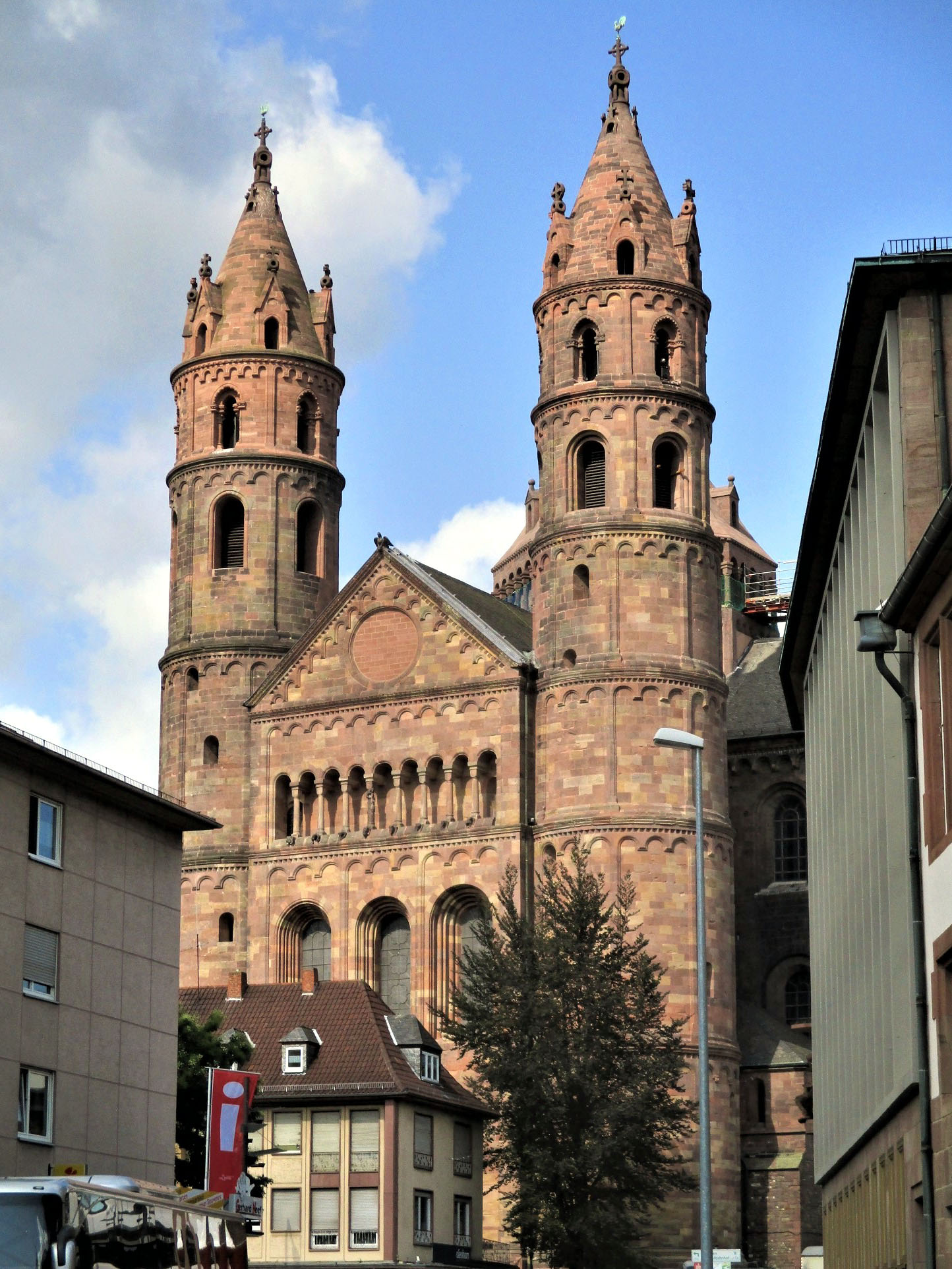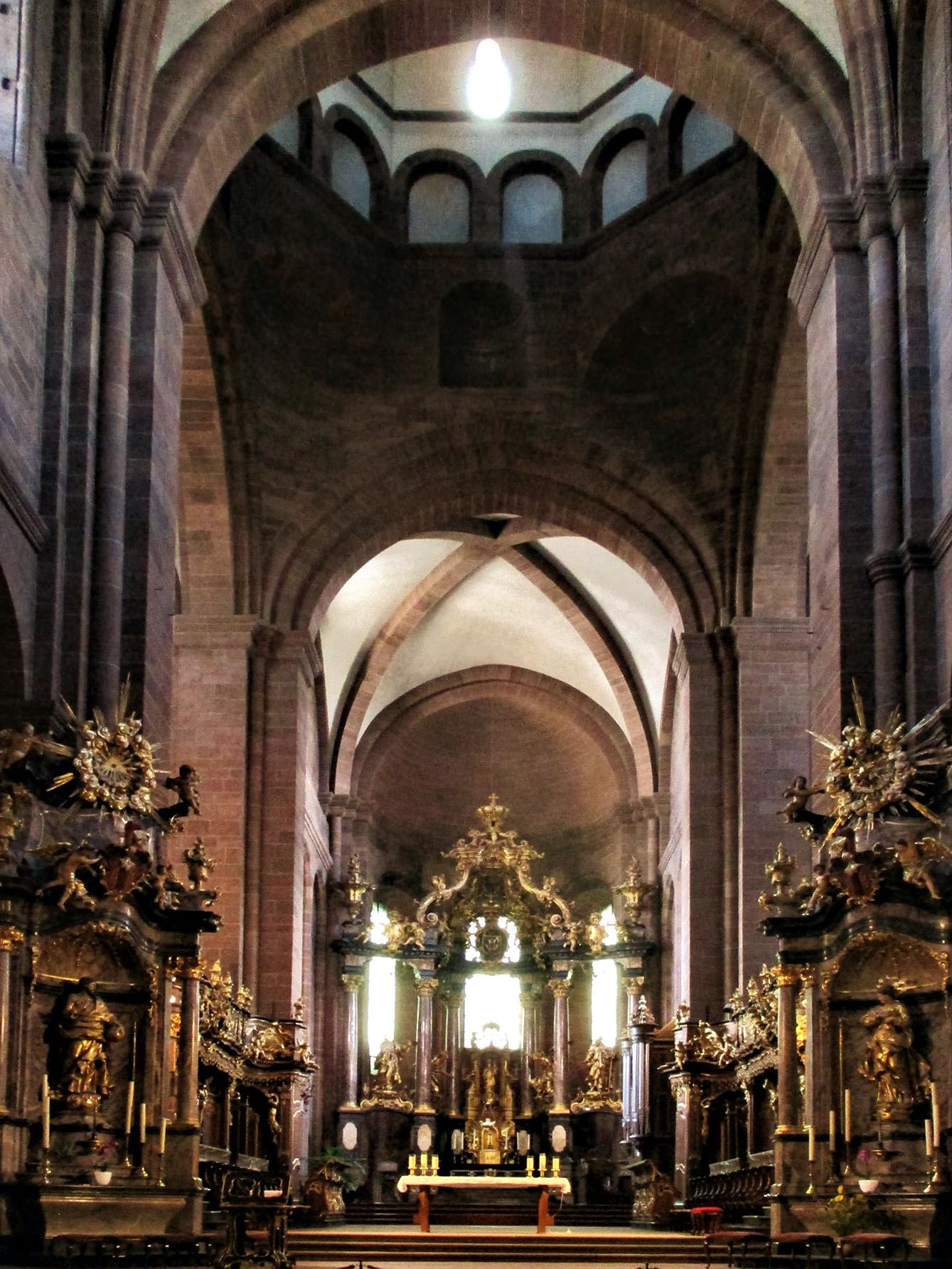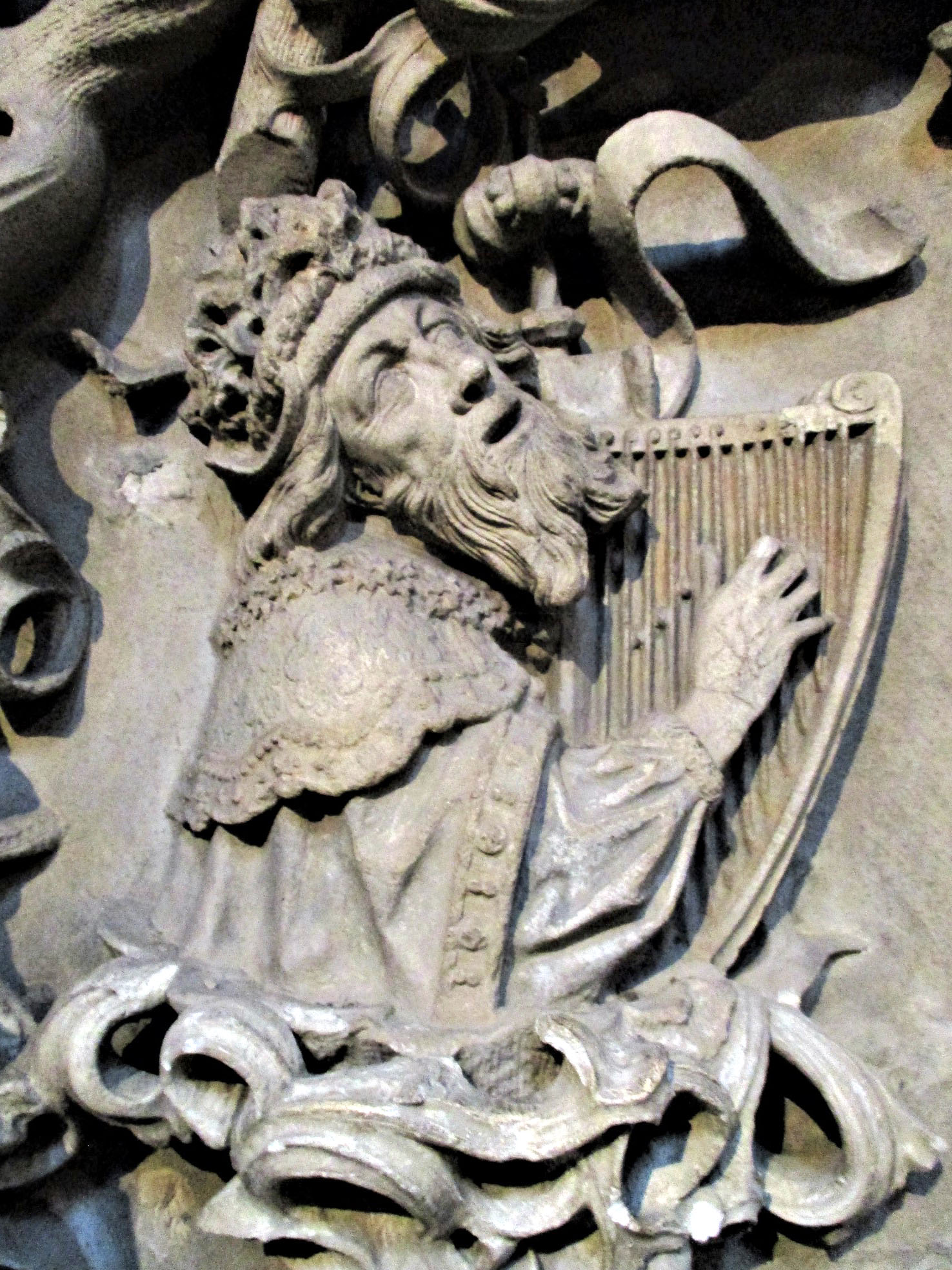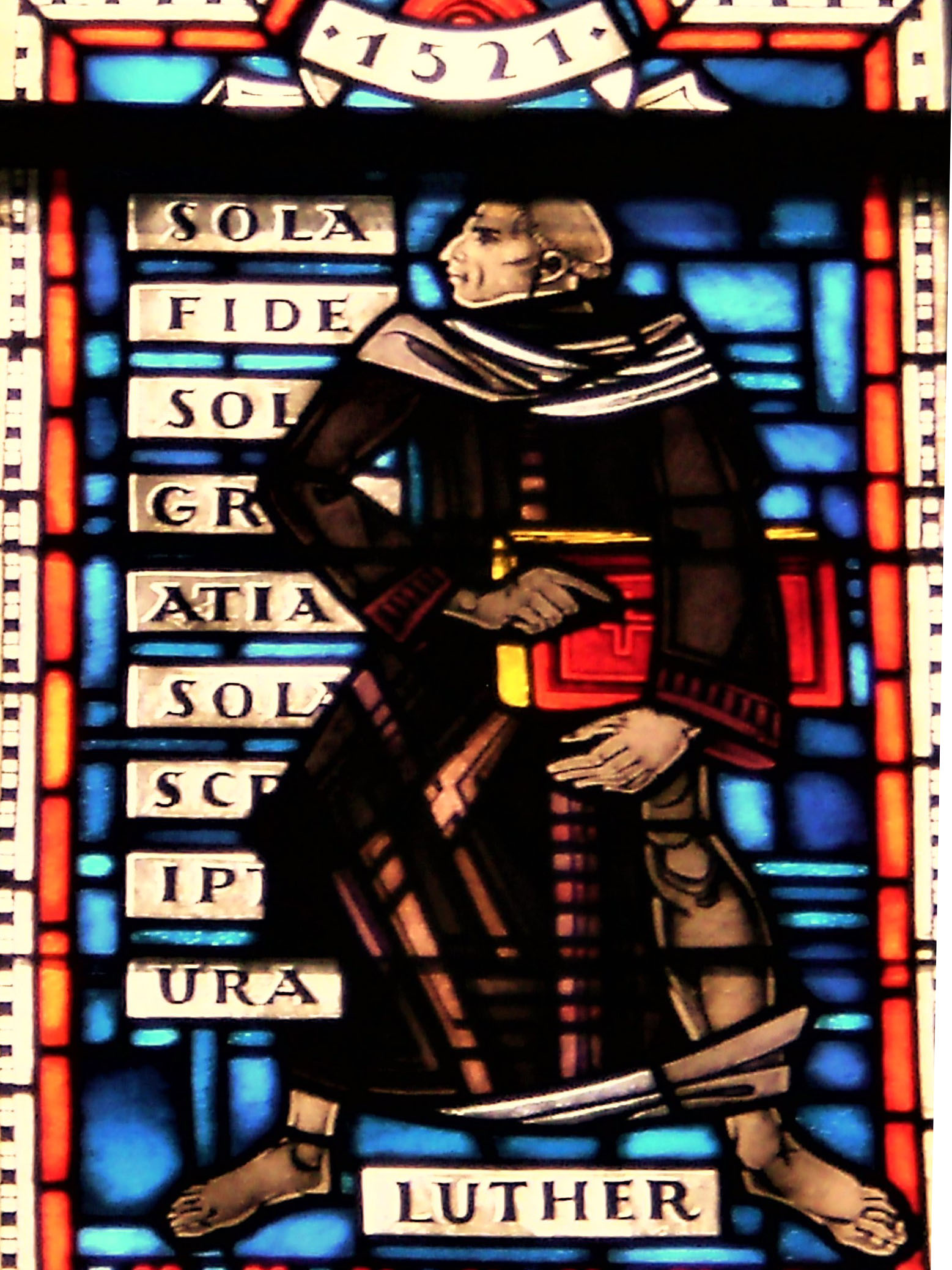| |
 |
 |
 |
| Comment on this report, or find other reports. |
 |
| Our Mystery Worshippers are volunteers who warm church pews for us around the world. If you'd like to become a Mystery Worshipper, start here. |
 |
| Find out how to reproduce this report in your church magazine or website. |
|
|
| 3221: Wormser Dom (Cathedral of St Peter), Worms, Germany |
 |
 |
 |
Mystery Worshipper: Portola.
The church: Wormser Dom (Cathedral of St Peter), Worms, Germany.
Denomination: Roman Catholic. In 1801, as a result of the restructuring of the Holy Roman Empire known as the Mediatization (Mediatisierung), the Diocese of Worms was terminated and Worms became part of the Diocese of Mainz.
The building: The predecessor of the present church was built in the 7th century and was replaced by a larger cathedral constructed from 1000-1025. The cathedral suffered damage from construction weaknesses and fires, so that it had to be rebuilt from 1125-1181. It has more or less retained its original shape: a cross-shaped Romanesque basilica with three naves, four towers, and domes over the two choirs.
Around 1300 a Gothic south portal and a St Nicholas chapel were added, which is used today for baptisms. There are five Gothic stone carvings in the north aisle: conspicuous is the depiction of the root of Jesse featuring a harp-playing King David.
During the Nine Years' War (1688–1697), French troops devastated and plundered the cathedral, burning it out completely, which is why the interior is now almost exclusively baroque. In 1792 French Revolutionary troops occupied the church, using it as a storage bin and horse barn. The restoration began in 1886 and was not completed until 1932. In 1945 the roof suffered heavy fire damage during Allied bomber attacks. Since 1961 comprehensive renovations and restorations have been carried out. Next year, 2018, the church will celebrate the 1000th anniversary of the original consecration.
The church: The cathedral parish of St Peter is united with the parish of St Martin, forming one congregation. This congregation started building a replacement for the two parish houses, which it would not be feasible to renovate. It will contain a café and shop. Above all, it will be used for parish activities, such as choir rehearsals, first communion preparation, confirmation instruction, etc. This house is also an attempt to reach out to the 350,000–400,000 tourists each year who visit the cathedral. However, this new, high and modern building will be directly adjacent to the cathedral, where it will block views of the cathedral, which has aroused forceful protests.
Among the activities of the congregation is an initiative to integrate refugees, declarations against right-wing extremism and populism, as well as participation in the 500 year Reformation commemoration.
The neighbourhood: Worms is a compact city with an incredible density of historical, cultural and religious richness. The immediate neighbourhood of the cathedral is loaded with history. Charlemagne (considered the Father of Europe) celebrated three Christmases and his wedding here. The Investiture Controversy, a power struggle between the emperor and the Pope regarding the right to appoint bishops – incorporating the question as to who is God’s chief representative on earth – was settled with the Concordat of Worms in 1122.
Worms was an assembly place for Emperors of the Holy Roman Empire.
About 100 meters from the cathedral is the place where Luther took his stand before Emperor and Empire on April 18, 1521, an event commemorated in a window of the cathedral. The Bishop’s Court, where Luther refused to recant his writings in the presence of Emperor Carl V, was destroyed by French troops in the 18th century; the spot where he stood is marked by a memorial. The cathedral was also the site of two religious conferences in 1540-41 and 1557, which were unsuccessful attempts to establish a consensus between Protestants and Catholics. Among the participants were John Calvin, Philipp Melanchthon and Martin Bucer, who innovated the Lutheran confirmation. Within a short walk of the cathedral is the world’s largest Reformation Memorial. It was created by the German sculptor Ernst Rietschel, completed in 1868. It features Martin Luther holding the Bible in a heroic pose, standing among Reformation figures and plaques representing the cities that first participated in the Reformation.
Worms was a center of Jewish scholarly study during the Middle Ages. Nearby is the oldest Jewish cemetery in Europe, called Holy Sand; the oldest visible gravestone dates from the year 1059. The Nazi regime wanted to bury this cemetery under a housing project, but the civic archivist told the prospective builders that he had given Heinrich Himmler a tour of the cemetery and that Himmler had declared it to be “very interesting.” Worms is also mentioned in the epic poem of the 12th century known as the Niebelungenlied (Song of the Nibelungs). The Burgundian kings, who settled in Worms in the 5th century, are the historical basis of this legendary saga which tells the story of Siegfried, an epic hero who slew a dragon and bathed in his blood to make himself impenetrable, not noticing that a leaf had fallen on his back between the shoulder blades, leaving one spot of vulnerability that eventually proved fatal.
Worms is located in a region that has produced wine since Roman times. The semi-sweet white wine known as Liebfrauenmilch (milk of our Beloved Lady) is produced within the city limits in a vineyard surrounding the Liebfrauenkirche (Church of Our Lady).
The cast: Herr Pfarrer Maximilian Wagner, presiding minister and preacher;
Herr Diakon Hans-Jürgen Springer, assisting minister.
The date & time: 20 August 2017, 10.00am.
What was the name of the service?
Hochamt (High Mass).
How full was the building?
An estimated 150 people filled about one-sixth of the seating.
Did anyone welcome you personally?
No.
Was your pew comfortable?
Yes.
How would you describe the pre-service
atmosphere?
Tourists, wearing mostly shorts and equipped with cameras and selfie sticks, were wandering back and forth through the nave until 15 minutes before the service, and then – as if in answer to prayer – miraculously disappeared. Despite bright sunshine, the cathedral was gloomy. People entered quietly and mostly individually. There were no animated greetings or lively conversations.

What were the exact opening words of the
service?
“In the name of the Father, and of the Son, and of the Holy Spirit.”
What books did the congregation use during the
service?
Gotteslob (God’s Praise) for the Diocese of Mainz, introduced in 2013.
What musical instruments were played?
An organ built by the Klais Orgelbau firm of Bonn in 1985. It is a so-called "swallow’s nest organ,” which term describes a tracker organ that sits on a platform built into the wall rather than sitting on the floor, with a tiny space for the organist to sit at the keyboard. Usually, organ tones in a church of this size sound blurred – as though one were sitting with the organ in an aquarium – but the organ music had a surprising crispness and clarity.
Did anything distract you?
During the gospel reading, an altar boy twiddled his thumbs underneath the cross hanging from his neck, causing it to dance up, down and sideways. During the eucharistic prayer, a man directly behind me blew his nose (one hopes into a handkerchief) with a sound comparable to a diesel horn. I have seldom been so taken aback!
Was the worship stiff-upper-lip, happy clappy, or
what?
It was an efficient, high church service with 26 candles, a chasuble, frequent use of incense, and eucharistic bells, which were twice rung six times. With a clear, pleasant voice, a woman sang a psalm, the Apostles’ Creed and the Agnus Dei, intertwined with short responses from the congregation. There were six altar servers dressed in green cassocks with white surplices. All sung elements of the service were indicated on a board displaying electronically the relevant numbers in the hymn book – with the exception of the Lord’s Prayer, which was sung by most of the congregation from memory. The closing hymn was addressed to Mary, “Queen of Cherubim and Seraphim,” with the appeal: “show us Jesus after the end (of life.)”
Exactly how long was the sermon?
9 minutes.
On a scale of 1-10, how good was the preacher?
5 – The preacher's introduction was not lucid and the development of the theme could have been more cohesive. On the other hand, I had the impression that he is a person of integrity, warmth and empathy.

In a nutshell, what was the sermon
about?
The sermon was based on the gospel reading (Mathew 15:21-28) about the Canaanite woman who appealed to Jesus to heal her daughter and refused to be put off by his apparent rudeness. She took Jesus at his word. The credibility of the trustworthiness of God’s promises was at stake, and she trusted unconditionally in Jesus’ willingness to help.
Do we really reckon with God’s help? The petitions of the Lord’s prayer – Thy kingdom come, give us this day our daily bread, forgive us our trespasses – are formulated in such a way that we are encouraged to approach God with confidence. Do we take God at his word?
Which part of the service was like being in
heaven?
Heavenly was the sense of being embedded in history. I was sitting in a church that was consecrated 999 years ago, which had been attended by emperors of the Holy Roman Empire; 100 meters to my left was the spot where Luther took a stand that changed the course of history. Before coming to the service I took a walk through the oldest Jewish cemetery in Europe, a park-like garden with lush green grass, ancient trees, and gravestones with Hebrew inscriptions that have not been disturbed for centuries.
And which part was like being in... er... the other place?
Whoever walks to this church cannot avoid stepping across a so-called Stolperstein (stumbling stone), a brass cube, cemented into the sidewalk, that documents that a Jewish person had lived in the house near this stone and was a victim of Nazi terror. Inscribed on the stone is the occupant’s name, date of deportation, the name of the concentration camp, and the date when the person was killed (if known). Currently there are 56,000 of these stumbling stones, located in 22 European countries. On my way to the church service I passed two of these stones, right across the street from the church, and carried the knowledge of the fate of the victims into the service: Irma and Moritz Mayer, deported 1942, murdered in the death camp Belzec.
What happened when you hung around after the service looking lost?
Anyone standing around after the service looks like one of the thousands of annual tourists who wander in and out. Also, this does not seem to be a congregation who take notice of Sunday visitors. I saw only one group of people who stayed around after the service talking with one another.
How would you describe the after-service
coffee?
No coffee.
How would you feel about making this church your regular (where 10 = ecstatic, 0 = terminal)?
1 – The service was enjoyable and uplifting, but as a non-Roman Catholic I could never feel at home here.

Did the service make you feel glad to be a
Christian?
Yes, indeed.
What one thing will you remember about all this in seven days' time?
"As a non-Catholic, I am not invited to holy communion, a restriction that I accept. However, as I contemplated whether or not to make an exception today, I became vividly aware of the nearby spot where Luther refused to sacrifice his theological integrity for the sake of an artificial unity. The Roman Catholic Church takes the same position as Luther with regard to holy communion with Protestants: a sacramental union that sacrifices theological integrity cannot be a blessing. This recognition, that Christianity can never sacrifice an uncompromising search for truth, is what will remain with me for more than a week. |
|
|
 |
 |
 |
| We rely on voluntary donations to stay online. If you're a regular visitor to Ship of Fools, please consider supporting us. |
 |
 |
 |
| The Mystery Pilgrim |
 |
| One of our most seasoned reporters makes the Camino pilgrimage to Santiago de Compostela in Spain. Read here. |
 |
 |
 |
| London churches |
 |
| Read reports from 70 London churches, visited by a small army of Mystery Worshippers on one single Sunday. Read here. |
| |
|
|
|
|


